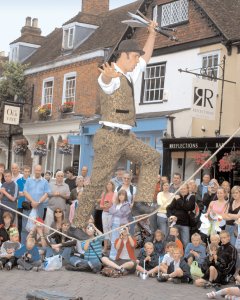Winchester Hat Fair is the longest running street festival of its kind in the UK. Kate Raines shares the challenges and the rewards of engaging with the artform.
Winchester Hat Fair gets its name from the tradition of hatting, or busking, for payment. Since Jonathan Kay founded the festival in 1974 it has developed to become one of the key events in the street arts calendar. The fair is part of a consortium, which includes Streets of Brighton, Greenwich and Docklands International Festival, Xtrax in Manchester and Stockton International Riverside Festival. For performers the Hat Fair has become a significant stop on the global circuit, being one of the few commissioning festivals with the potential to attract promoters. This, together with the fact that Winchester audiences are known to be extremely interactive and generous, has given it prominence in the annual events diary.
The artistic quality of the festival is maintained by a three-strand system of programming. Selected acts are retained year on year and permitted to hat for money, other small-scale acts are fee-paid and a third strand consists of commissioned work for which the festival receives funding. Long-term associations with artists promote the drive to develop the sector nationally and are conducive to partnerships and co-commissions, including the National Theatre and Laban. Director of Celebrations, Sian Thomas maintains that the overriding criterion for booking an act is its ability to engage the audience.
Far from being an imposed artistic programme, it is one that has truly evolved out of a sense of place. The city, the people and the artistic programme are interwoven, creating a sense of community celebration. Thomas brings new genres of work to the festival from her wide knowledge of the sector. The spectacular Bollywood Steps performance of 2006 was booked not only because of its cultural diversity, but because it lent itself perfectly to the large set of steps outside the law courts. Equally, Produccionnes Imperdibles mesmerising dance on a raised glass platform, viewed by the audience from beneath, was lent a new perspective by being performed in the cathedral, with its elevated backdrop of intricately carved ceiling.
In terms of audience development, the issue according to Thomas, is not how to grow the audience, which at the last count stood at 30,000 external visitors, but how to manage the steady annual increase. Furthermore, the challenge exists to develop audience understanding and appreciation of new site-specific pieces and commissions.
Traditionally the UK has lagged behind countries such as Poland, France, the Netherlands and Spain in terms of its support for street arts but it is rapidly catching up. The staging of The Sultans Elephant by French street theatre company Royal de Luxe in central London last year amply demonstrated just how powerful the form can be to a huge audience. For the Hat Fair, the international nature of the programme lends a new vitality to the event and confers a status on the city, which would be difficult to achieve by other means.

The festival is supported by Arts Council England, whose steady increase in funding over recent years has reflected its support of the artistic ambition of the Hat Fair and street arts in general. In addition, Winchester City Council and Hampshire County Council lend their support, both directly and in kind. Crucially, the funding creates more performing opportunities for artists and allows them to push the boundaries of their work. It provides for a part-time director and assistant, but the Fair still relies heavily on volunteers. Jonathan Kay asserts that the return on investment is huge, with last years funding of £150,000 generating estimated revenue of £3.5m throughout the city.
Street arts status relative to other more established art forms has moved forward in leaps and bounds. As Kay says, What is the street for? It is a great creative space. Street art is one of the most direct ways to get people involved in theatre.
Kate Raines is Press Officer at Theatre Royal Winchester and at The Point, Eastleigh. Winchester Hat Fair runs from 28 June to 1 July.
w: http://www.hatfair.co.uk



